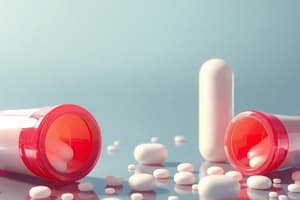Podcast
Questions and Answers
What is the maximum amount of flavoring agents that can be used in chewable tablets?
What is the maximum amount of flavoring agents that can be used in chewable tablets?
- 1-1.5%
- 2-2.5%
- 0.5-0.75% (correct)
- 3-3.5%
Which sweetening agent is sweeter than sucrose but can give a bitter aftertaste and is considered to be carcinogenic?
Which sweetening agent is sweeter than sucrose but can give a bitter aftertaste and is considered to be carcinogenic?
- Stevia
- Sucrose
- Aspartame
- Saccharin (correct)
What do adsorbents do in the production of tablets?
What do adsorbents do in the production of tablets?
- Convert oily drugs to apparently dry state (correct)
- Convert oily drugs to liquid state
- Improve tablet stability
- Enhance dissolution
Which polymer is used in tablets to retard dissolution?
Which polymer is used in tablets to retard dissolution?
What is the role of wetting agents in tablets containing poorly soluble drugs?
What is the role of wetting agents in tablets containing poorly soluble drugs?
What is the main disadvantage of using sucrose as a sweetening agent?
What is the main disadvantage of using sucrose as a sweetening agent?
What is the first step in the wet granulation process for tablet manufacture?
What is the first step in the wet granulation process for tablet manufacture?
Which process can be used for tablet production without initial granulation?
Which process can be used for tablet production without initial granulation?
What is the purpose of using sodium carboxymethylcellulose in tablet production through direct compression?
What is the purpose of using sodium carboxymethylcellulose in tablet production through direct compression?
When is the disintegrant added in the dry granulation process?
When is the disintegrant added in the dry granulation process?
What is the method of choice for tablet production with powder moisture or thermosensitive ingredients?
What is the method of choice for tablet production with powder moisture or thermosensitive ingredients?
Which excipient is typically included to provide flowability and cohesive features to the powder mixture for tablet production through direct compression?
Which excipient is typically included to provide flowability and cohesive features to the powder mixture for tablet production through direct compression?
What is the main advantage of the direct compression process for tablet manufacture?
What is the main advantage of the direct compression process for tablet manufacture?
Flashcards
Maximum allowable flavoring agents in chewable tablets
Maximum allowable flavoring agents in chewable tablets
The regulated amount of flavoring agents allowed in chewable tablets, which may vary by region.
Aspartame as a sweetening agent
Aspartame as a sweetening agent
A sweetening agent sweeter than sucrose, but potentially carcinogenic, and with a bitter aftertaste.
Adsorbents in tablet production
Adsorbents in tablet production
Substances added to absorb moisture, maintaining tablet stability and preventing degradation.
HPMC in tablets
HPMC in tablets
Signup and view all the flashcards
Wetting agents for poorly soluble drugs
Wetting agents for poorly soluble drugs
Signup and view all the flashcards
Disadvantage of Sucrose
Disadvantage of Sucrose
Signup and view all the flashcards
First step in wet granulation
First step in wet granulation
Signup and view all the flashcards
Direct compression tablet production
Direct compression tablet production
Signup and view all the flashcards
Sodium carboxymethylcellulose's role
Sodium carboxymethylcellulose's role
Signup and view all the flashcards
Disintegrant in dry granulation
Disintegrant in dry granulation
Signup and view all the flashcards
Method for moisture-sensitive ingredients
Method for moisture-sensitive ingredients
Signup and view all the flashcards
Flowability and cohesion in direct compression
Flowability and cohesion in direct compression
Signup and view all the flashcards
Advantage of direct compression
Advantage of direct compression
Signup and view all the flashcards
Study Notes
Flavoring Agents in Chewable Tablets
- Maximum allowable amount of flavoring agents in chewable tablets is typically regulated, but specific limits may vary by region.
Sweetening Agents
- Aspartame is a sweetening agent that is sweeter than sucrose, known for causing a bitter aftertaste and considered to be potentially carcinogenic.
Role of Adsorbents
- Adsorbents are added in tablet production to absorb moisture, preventing degradation and ensuring stability of the final product.
Dissolution-Retarding Polymers
- Hydroxypropyl methylcellulose (HPMC) is commonly used to retard dissolution in tablets, controlling the release rate of the active ingredient.
Wetting Agents in Poorly Soluble Drugs
- Wetting agents aid solubility and improve the dissolution of poorly soluble drugs in tablet formulations.
Disadvantage of Sucrose
- Sucrose can lead to dental caries and may cause fluctuations in blood glucose levels, making it less desirable for some formulations.
First Step in Wet Granulation
- The initial step involves the mixing of active ingredients with a binder to form a wet mass.
Tablet Production without Granulation
- The direct compression method enables tablet production without the need for initial granulation, simplifying the process.
Purpose of Sodium Carboxymethylcellulose
- Sodium carboxymethylcellulose serves as a binder and disintegrant in direct compression tablet production, enhancing tablet integrity and dissolution.
Disintegrant Addition in Dry Granulation
- In the dry granulation process, disintegrants are typically added after the granules are formed, ensuring effective decomposition of the tablet upon ingestion.
Method for Moisture or Thermosensitive Ingredients
- The direct compression process is the preferred method for tablet production when dealing with moisture-sensitive or thermosensitive ingredients, as it avoids heat and excessive moisture exposure.
Flowability and Cohesion in Direct Compression
- Microcrystalline cellulose is commonly included to enhance flowability and cohesive properties of the powder mixture for direct compression tablet production.
Advantage of Direct Compression
- Direct compression offers a faster manufacturing process and reduces the need for additional processing steps, making it more efficient and cost-effective.
Studying That Suits You
Use AI to generate personalized quizzes and flashcards to suit your learning preferences.




